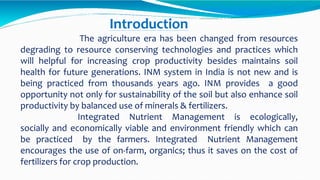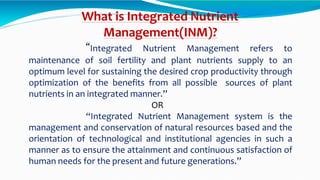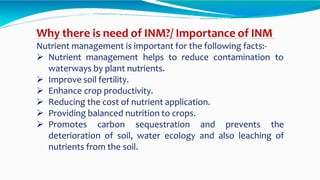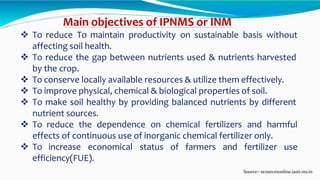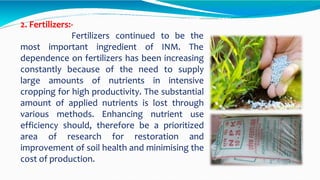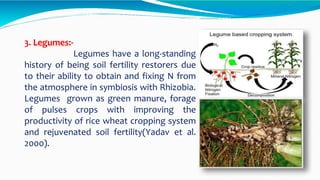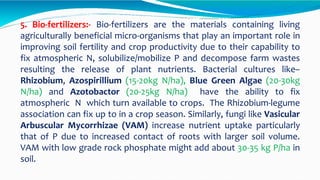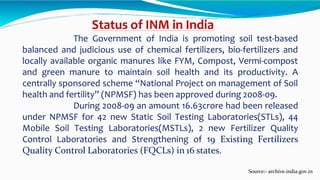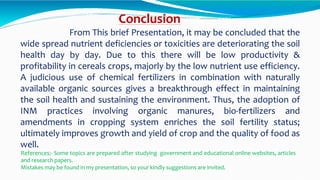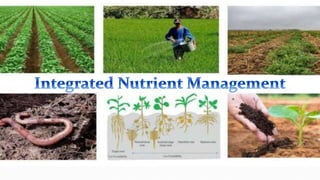integrated nutrient management and its importance.pptx
- 2. Introduction The agriculture era has been changed from resources degrading to resource conserving technologies and practices which will helpful for increasing crop productivity besides maintains soil health for future generations. INM system in India is not new and is being practiced from thousands years ago. INM provides a good opportunity not only for sustainability of the soil but also enhance soil productivity by balanced use of minerals & fertilizers. Integrated Nutrient Management is ecologically, socially and economically viable and environment friendly which can be practiced by the farmers. Integrated Nutrient Management encourages the use of on-farm, organics; thus it saves on the cost of fertilizers for crop production.
- 3. What is Integrated Nutrient Management(INM)? “Integrated Nutrient Management refers to maintenance of soil fertility and plant nutrients supply to an optimum level for sustaining the desired crop productivity through optimization of the benefits from all possible sources of plant nutrients in an integrated manner.” OR “Integrated Nutrient Management system is the management and conservation of natural resources based and the orientation of technological and institutional agencies in such a manner as to ensure the attainment and continuous satisfaction of human needs for the present and future generations.”
- 4. Main Concept of INM The integrated plant nutrition management is known as integrated nutrient management thus firstly operates at plot level, optimizing the utilization of plant nutrients from diverse sources which are locally available, in order to improve the agronomic efficiency of such nutrient and at the same time reducing the losses of nutrients. Organic recycling is especially promoted through INM for facilitating nutrient recycling to improve soil fertility and productivity as low cost.
- 5. Why there is need of INM?/ Importance of INM Nutrient management is important for the following facts:- Nutrient management helps to reduce contamination to waterways by plant nutrients. Improve soil fertility. Enhance crop productivity. Reducing the cost of nutrient application. Providing balanced nutrition to crops. Promotes carbon sequestration and prevents the deterioration of soil, water ecology and also leaching of nutrients from the soil.
- 6. Main objectives of IPNMS or INM To reduce To maintain productivity on sustainable basis without affecting soil health. To reduce the gap between nutrients used & nutrients harvested by the crop. To conserve locally available resources & utilize them effectively. To improve physical, chemical & biological properties of soil. To make soil healthy by providing balanced nutrients by different nutrient sources. To reduce the dependence on chemical fertilizers and harmful effects of continuous use of inorganic chemical fertilizer only. To increase economical status of farmers and fertilizer use efficiency(FUE). Source:- ecourcesonline.iasri.res.in
- 7. Components of INM manures, Fertilizers, organic residues and legumes, bio-fertilizers are the crop main components of INM:- 1. Organic Manures:- Organic Manures like urban compost, FYM, crop residues, human excreta, sewage and sludge and other agro- industrial wastes have large nutrient potential. Organic manures are bulky nature and with low nutrient supply. Organic manures not only supply macro and micronutrients , but also help improving the physical, chemical and biological properties of the soil Source:- biotecharticles.com
- 8. 2. Fertilizers:- Fertilizers continued most important ingredient to be the of INM. The dependence on fertilizers has been increasing constantly because of the need to supply large amounts of nutrients in intensive cropping for high productivity. The substantial amount of applied nutrients is lost through various methods. Enhancing nutrient use efficiency should, therefore be a prioritized area of research for restoration and improvement of soil health and minimising the cost of production.
- 9. 3. Legumes:- Legumes have a long-standing history of being soil fertility restorers due to their ability to obtain and fixing N from the atmosphere in symbiosis with Rhizobia. Legumes grown as green manure, forage of pulses crops with improving the productivity of rice wheat cropping system and rejuvenated soil fertility(Yadav et al. 2000).
- 10. 4. Crop Residues:- Crop Residues have many uses and available as an ingredient of INM, in North-West India where mechanical harvesting is practised, residues are left in the field, which can be a part of nutrient supply. The are large amount of residues like potato, sugarcane, which are practically waste in most case while residues of cereals are valuable for cattle feed and could be used as organic manuring after decomposing. Recycling of these residues in fields helps to build stable organic matter in the soil, as also to sustain the crop yields.
- 11. 5. Bio-fertilizers:- Bio-fertilizers are the materials containing living agriculturally beneficial micro-organisms that play an important role in improving soil fertility and crop productivity due to their capability to fix atmospheric N, solubilize/mobilize P and decompose farm wastes resulting the release of plant nutrients. Bacterial cultures like– Rhizobium, Azospirillium (15-20kg N/ha), Blue Green Algae (20-30kg N/ha) and Azotobactor (20-25kg N/ha) have the ability to fix atmospheric N which turn available to crops. The Rhizobium-legume association can fix up to in a crop season. Similarly, fungi like Vasicular Arbuscular Mycorrhizae (VAM) increase nutrient uptake particularly that of P due to increased contact of roots with larger soil volume. VAM with low grade rock phosphate might add about 30-35 kg P/ha in soil.
- 12. Blue Green Algae Legumes VAM Azospirillum Azotobactor
- 13. Advantages of Integrated Nutrient Management
- 14. Contraints/Difficulties in Adoption of INM of the There are some constraints facing the progress Integrated nutrient Management:- Difficulties occurs in obtaining FYM and bio-fertilizers, some poor farmers have some trouble obtaining organic manures as well as lack of knowledge and skills of recycling organic wastes to produce high quality compost. Biotic and abiotic stresses are ranked to second reason. Third reason will be the poor tillage. Lack of equipment was ranked fourth reason. Absence of the role of extension services and NGO’s to support farmers to adopt INM. Finally all of these reason could hardly be detected and might be solved. Source:- hindawi.com
- 15. Effects/Results of INM A field experiment was conducted during kharif 2009-10 for two years with rice as the test crop at Regional Agricultural Research Station, Anakapalle, Visakhapatnam(AP). Micro nutrient status in submerged rice soil at harvest irrespective of the treatments, the available micronutrient status (Zn, Fe, Cu and Mn) observed under integrated nutrient treatments were higher over chemical fertilizers alone. The results indicated that the available Mg status varied from 7.4-15.2 during2009 and 7.0-16.5 mg kg-1 during 2010 respectively. More other micronutrient build up was observed during second year over first year in all the integrated nutrient management. The results are well supported by the findings of Ramesh et al. (2006) and Banik and Sharma (2008). Significantly higher grain yields were recorded when 25% N was applicated through INM method or components. Source:- Research Paper of Regional Agricultural Research Station, Anakapalle
- 16. Status of INM in India The Government of India is promoting soil test-based balanced and judicious use of chemical fertilizers, bio-fertilizers and locally available organic manures like FYM, Compost, Vermi-compost and green manure to maintain soil health and its productivity. A centrally sponsored scheme “National Project on management of Soil health and fertility” (NPMSF) has been approved during 2008-09. During 2008-09 an amount 16.63crore had been released under NPMSF for 42 new Static Soil Testing Laboratories(STLs), 44 Mobile Soil Testing Laboratories(MSTLs), 2 new Fertilizer Quality Control Laboratories and Strengthening of 19 Existing Fertilizers Quality Control Laboratories (FQCLs) in 16 states. Source:- archive.india.gov.in
- 17. Conclusion From This brief Presentation, it may be concluded that the wide spread nutrient deficiencies or toxicities are deteriorating the soil health day by day. Due to this there will be low productivity & profitability in cereals crops, majorly by the low nutrient use efficiency. A judicious use of chemical fertilizers in combination with naturally available organic sources gives a breakthrough effect in maintaining the soil health and sustaining the environment. Thus, the adoption of INM practices involving organic manures, bio-fertilizers and amendments in cropping system enriches the soil fertility status; ultimately improves growth and yield of crop and the quality of food as well. References:- Some topics are prepared after studying government and educational online websites, articles and research papers. Mistakes may be found in my presentation, so your kindly suggestions are invited.


